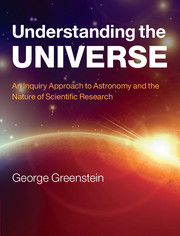Book contents
- Frontmatter
- Contents
- Preface
- Acknowledgments
- Part I Introducing steps to astronomy
- Part II The Solar System
- 6 Introducing the Solar System
- 7 The inner Solar System
- 8 The outer Solar System
- 9 Smaller bodies in the Solar System
- 10 Planets beyond the Solar System
- Part III Introducing stars
- Part IV Introducing galaxies and the Universe
- Epilog
- Appendix I The small-angle formula
- Appendix II Exponential notation
- Appendix III The Solar System
- Appendix IV The closest and brightest stars
- Appendix V Physical and astronomical constants
- Appendix VI Conversion factors
- Appendix VII Constellation maps
- Glossary
- Figure Credits
- Index
- Plate section
10 - Planets beyond the Solar System
from Part II - The Solar System
Published online by Cambridge University Press: 05 February 2013
- Frontmatter
- Contents
- Preface
- Acknowledgments
- Part I Introducing steps to astronomy
- Part II The Solar System
- 6 Introducing the Solar System
- 7 The inner Solar System
- 8 The outer Solar System
- 9 Smaller bodies in the Solar System
- 10 Planets beyond the Solar System
- Part III Introducing stars
- Part IV Introducing galaxies and the Universe
- Epilog
- Appendix I The small-angle formula
- Appendix II Exponential notation
- Appendix III The Solar System
- Appendix IV The closest and brightest stars
- Appendix V Physical and astronomical constants
- Appendix VI Conversion factors
- Appendix VII Constellation maps
- Glossary
- Figure Credits
- Index
- Plate section
Summary
As we saw in Chapter 8, finding new planets is hard. Uranus, the first planet not visible to the naked eye, was discovered in 1781, Neptune in 1846 and Pluto in 1930. That works out to only one new planet in each of the last three centuries! But in recent years the pace of discovery has accelerated spectacularly. A new planet was discovered in 1995; by now more than a thousand potential candidates have been found. Plans are under way for yet more dramatic advances in technology, which should greatly improve our ability to find these new worlds.
Most remarkable of all is that none of these new planets orbits our own Sun. They are orbiting the distant stars.
These discoveries have completely changed our view of our place in the Universe. Until the first of these new worlds was discovered, for all we knew our own Solar System might have been unique. If so, we would have been utterly alone in the cosmos. But by now we know that planets are common. This has dramatic implications for the search for life elsewhere in the Universe.
Direct detection of extrasolar planets
How have these far-distant worlds been found? You might think that they were discovered in just the same way that planets in our own Solar System were: just by looking for them through a telescope. Remarkably, however, this was not the case. In almost every case, even though we know of their existence, we have never seen these new worlds.
- Type
- Chapter
- Information
- Understanding the UniverseAn Inquiry Approach to Astronomy and the Nature of Scientific Research, pp. 296 - 314Publisher: Cambridge University PressPrint publication year: 2013



